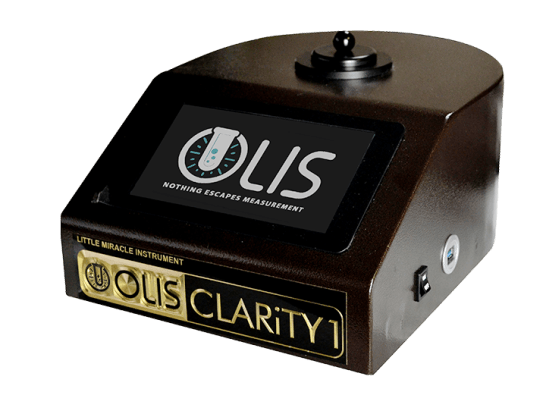The Basic Principles Of Circularly Polarized Luminescence
The Basic Principles Of Circularly Polarized Luminescence
Blog Article
The 5-Minute Rule for Spectrophotometers
Table of ContentsSome Of SpectrophotometersCircularly Polarized Luminescence for DummiesThings about Circularly Polarized LuminescenceFascination About Circularly Polarized LuminescenceCircularly Polarized Luminescence Fundamentals Explained

Although spectrophotometry is most commonly applied to ultraviolet, noticeable, and infrared radiation, modern spectrophotometers can question wide swaths of the electromagnetic spectrum, including x-ray, ultraviolet, noticeable, infrared, and/or microwave wavelengths. Spectrophotometry is a tool that depends upon the quantitative analysis of particles depending on just how much light is soaked up by colored compounds.
Uv/vis/nir Can Be Fun For Anyone
A spectrophotometer is frequently used for the measurement of transmittance or reflectance of solutions, transparent or opaque solids, such as refined glass, or gases. Although numerous biochemicals are colored, as in, they take in visible light and therefore can be measured by colorimetric procedures, even colorless biochemicals can frequently be converted to colored substances appropriate for chromogenic color-forming responses to yield substances ideal for colorimetric analysis.: 65 Nevertheless, they can likewise be created to determine the diffusivity on any of the noted light varieties that normally cover around 2002500 nm utilizing different controls and calibrations.
An example of an experiment in which spectrophotometry is utilized is the decision of the stability constant of a solution. A certain chain reaction within an option might occur in a forward and reverse direction, where reactants form items and products break down into reactants. At some point, this chain reaction will reach a point of balance called a stability point.
Not known Facts About Circular Dichroism
The amount of light that goes through the solution is indicative of the concentration of particular chemicals that do not enable light to go through. The absorption of light is because of the interaction of light with the electronic and vibrational modes of molecules. Each kind of molecule has a private set of energy levels related to the makeup of its chemical bonds and nuclei and hence will take in light of particular wavelengths, or energies, leading to special spectral properties.
Making use of spectrophotometers spans numerous clinical fields, such as physics, materials science, chemistry, biochemistry. spectrophotometers, chemical engineering, and molecular biology. They are widely used in lots of industries consisting of semiconductors, laser and optical production, printing and forensic assessment, in addition to in labs for the study of chemical compounds. Spectrophotometry is typically used in measurements of enzyme activities, decisions of protein concentrations, determinations of enzymatic kinetic constants, and measurements of ligand binding reactions.: 65 Ultimately, a spectrophotometer is able to figure out, depending upon the control or calibration, what substances exist in a target and precisely how much through calculations of observed wavelengths.
Developed by Arnold O. Beckman in 1940 [], the spectrophotometer was created with the help of his colleagues at his business National Technical Laboratories established in 1935 which would become Beckman Instrument Business and ultimately Beckman Coulter. This would come as a service to the formerly developed spectrophotometers which were unable to take in the ultraviolet correctly.
Excitement About Circular Dichroism
It would be discovered that this did not provide acceptable outcomes, therefore in Design B, there was a shift from a glass to a quartz prism which enabled for much better absorbance results - UV/Vis/NIR (https://nowewyrazy.uw.edu.pl/profil). From there, Design C was born with a modification to the wavelength resolution which wound up having three systems of it produced
It was produced from 1941 to 1976 where the price for it in 1941 was US$723 (far-UV devices were a choice at additional cost). webpage In the words of Nobel chemistry laureate Bruce Merrifield, it was "most likely the most crucial instrument ever developed towards the improvement of bioscience." Once it ended up being ceased in 1976, Hewlett-Packard developed the first commercially available diode-array spectrophotometer in 1979 known as the HP 8450A. It irradiates the sample with polychromatic light which the sample takes in depending upon its residential or commercial properties. Then it is transmitted back by grating the photodiode selection which finds the wavelength area of the spectrum. Since then, the development and implementation of spectrophotometry gadgets has actually increased exceptionally and has actually become one of the most ingenious instruments of our time.

Spectrophotometers Things To Know Before You Buy
Historically, spectrophotometers utilize a monochromator containing a diffraction grating to produce the analytical spectrum. The grating can either be movable or repaired. If a single detector, such as a photomultiplier tube or photodiode is used, the grating can be scanned stepwise (scanning spectrophotometer) so that the detector can measure the light strength at each wavelength (which will correspond to each "step").
In such systems, the grating is fixed and the strength of each wavelength of light is determined by a various detector in the range. When making transmission measurements, the spectrophotometer quantitatively compares the fraction of light that passes through a referral service and a test service, then digitally compares the strengths of the two signals and computes the percentage of transmission of the sample compared to the recommendation standard.

Report this page